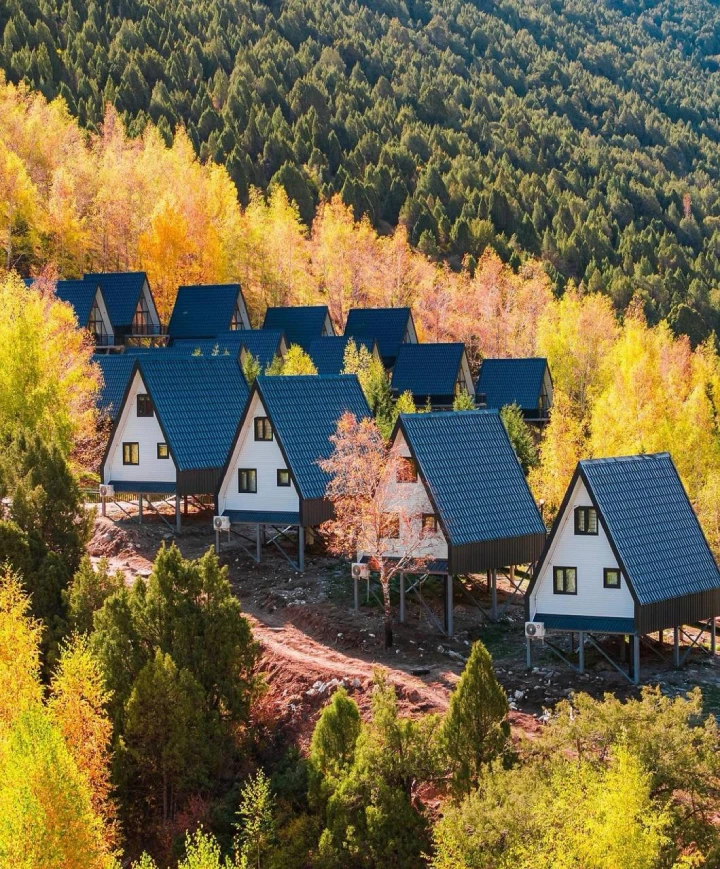
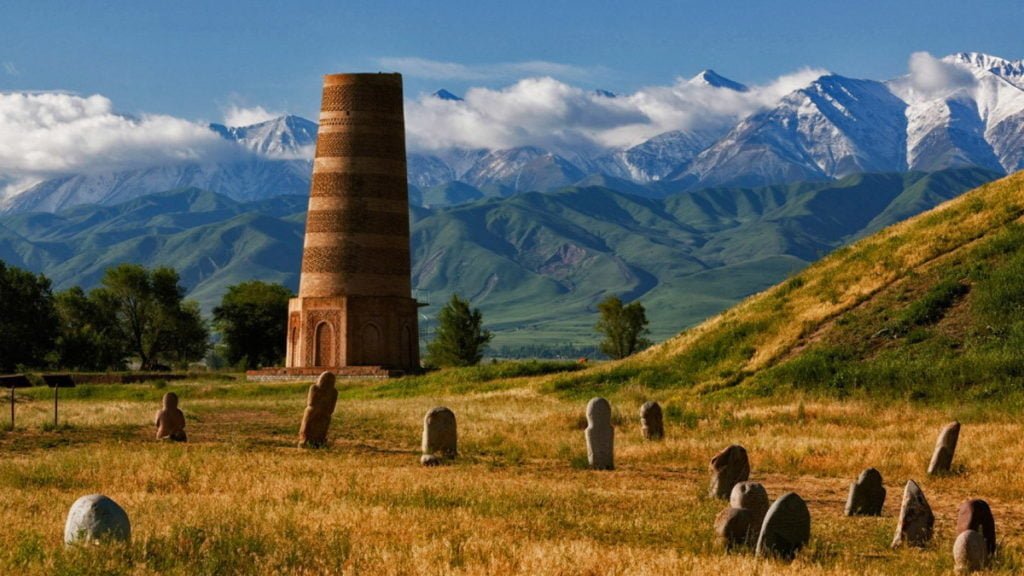
Burana Tower
Burana Tower is a historical and architectural landmark located in the Chui Valley of Kyrgyzstan, near the town of Tokmok. It is a minaret that dates back to the 11th century and was part of the ancient city of Balasagun, which was once a significant city in the medieval Islamic world and an important stop on the Silk Road.

Here are some key points about Burana Tower:
Historical Significance: Burana Tower was built during the Karakhanid period, which was a Turkic dynasty that ruled over parts of Central Asia from the 9th to the 13th centuries. Balasagun was the capital of the Karakhanid Empire and a prominent center of trade, culture, and learning.
Architecture: The tower stands at about 25 meters (82 feet) tall, though it originally may have been taller. It is made of baked brick and is cylindrical in shape, with a tapering top. The tower has been damaged over the centuries, especially by earthquakes, but it still stands as an impressive example of medieval Islamic architecture.
Cultural Context: The tower served as a minaret for a mosque that was likely part of a larger complex in Balasagun. It is not only an architectural feature but also a symbol of the spread of Islam in the region during that period.
Burana Tower Complex: The area around the tower includes a small museum, the remains of ancient buildings, and a collection of balbals (stone statues of warriors or notable figures) that provide insights into the early Turkic and nomadic cultures of the region. These balbals are among the most important archaeological finds in the area and are thought to mark the graves of important people.
Tourism: Burana Tower is now a popular tourist destination in Kyrgyzstan. The site is easily accessible and offers a picturesque view of the surrounding Chui Valley. Visitors can climb the tower, enjoy the historical context, and see the nearby archaeological remains.
The tower is often seen as a symbol of Kyrgyzstan’s rich history and a testament to the cultural exchange along the Silk Road, which connected various civilizations across Asia and Europe.
How To Get To The Burana Tower
Visiting the Burana Tower can easily be done as a day trip from Bishkek.
From Bishkek you first need to head to the town of Tokmok. Take a city mashrutka from Bus station and jump on a minibus to Tokmok. It should take less than two hours and cost 300 som.
When you get to Tokmok your best bet is to take a taxi to Burana. Find a driver and negotiate price (maybe around 1000 som). Make sure you ask them to wait for you unless you want to be hitching back to Tokmok.
Burana tower.
The museum complex of Burana consists of ruins, fortresses, minarets, mausoleums from the 10-12 centuries, museums and monumental stone carvings from the 5-10 centuries, which existed in the central part of Balasagyn town.
In the museum collection there are more than 2000 items, which were found in the territory of the medieval town of Bal-asagyn and near its fortresses. It includes unique collections of ceramic and bronze wares, wares made of bronze, stones with inscriptions, numismatic finds and military materials.
The founding of the town of Burana – Capital of Karakhanid empire.
The existence of the early medieval town of Balas-agyn is proved by significant information from medieval authors. Many writing sources, which are in Chinese, Arabic and Persian language, mentioned about a big town on the Silk Way Road. The name of the place “Burana” comes from the preserved minaret in the 10th -12th century. It was the moment of the formation of Karakhanid state, famous as Kuz-Ordu, Kuz-Balyk, Orduken, Go Balyk, Monara. The findings of Tur-gesh coins around Balasagyn give us important information about the foundation of town in the 8th century of the early Middle Ages. This opinion can be proved by additional archeological finds, which date from the 8th century until the 9th.
There is also a find of burials with horses around this area, which date to this time. There were sets of belts in the burial places. The belt was peculiar sign of distinction, showing service in battle and military status of warrior. A Turkic warrior couldn’t dispense with a belt. There were a dagger, saber, grindstone, and leather bag on the belt for flint and steel. Belts were decorated with bronze and Silver cover plates. Interestingly, this finding was on the female burial in the Balasagyn territory.
Buddhist Monument in Burana tower
Buddhist monuments found in the territory of Balasagyn can also be evidence about the Middle Ages, Buddhism came to the Chui valley in the middle of the 8th century but after the battle of Talas where Arabs and Karluks defeated the Chinese in 751 Buddhism wasn’t spread further.
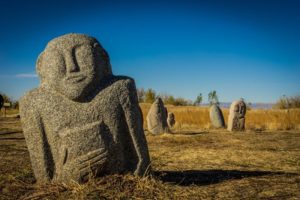
About the Karakhanid state
During the 10th century and the l 2th century Karakhanid empire reached its cultural fullest flower and power in Tyan-Shan. The term
“karakhanid” is brought to the science according to the status of the first ruler of the dynasty who accepted Islam, Satuk Abd al-Kerim Kara-khan. Many representatives of this dynasty carried the title
“kara-khan” or kara-hakan. The Turkic word “kara” (black) suggests great and supreme (high). The names of the totemic animals “bugra” (camel) and
“arslan” (lion) in combination with the term “khan” (bugra-khan, arslan-khan) were the most widespread and honorable titles of Karakhanid rulers.
According to written sources Turkic tribes lived in Central Tien-Shan and Semirechie in the 10th century. There were Karluks, Yagmas, Chig-ils, Turgesh, Oguzo-turkmens, Kipchaks, Kenjeks, Yabaks, Kurguz, Turkic Sogdians and Argu. The first four tribes played a central role in founding the Karakhanid state during 940.
Later the borders of Karakhanid’s state expanded to the east, up to the river Amu-Darya. In 1041 – 1042, the Karakhanid state divided into two independent states with their own ruler and capital.
The capital of the Eastern kaganate (state) became Balasagyn, and the Western kaganate capital was Uzgen, and later Samarkand. From 1069, in accordance with a peace treaty, the accepted border between the eastern and western possessions became Khodjent. After that, the Ferghana valley and territory from the Syr-Darya were under the power of eastern ruler Karakhanid, Togrul kara-khan.
Medieval written information about Balasagyn
The period of Karakhanids ruling was the highest development of feudalistic relationships, agri-culture, trade and politics. It is a very important process of ethnogeny among Turkic peoples, rise of Turkic culture and its language. During this period many writers wrote their famous works in Turkic language which soon became a classic of East, Usup Has-Hadjib (poem “Kutadgu Bilig-A fertile field”), famous scholar Mahmud Kashkari from Barskhan (dictionary of Turkic adverbs “Divan lugat at-turk”) Written evidence tells us many interesting facts about names of towns, inhabitants, spiritual culture and later destiny of Balasagyn. Here are some of the main things from them.
Mahmud Kashgari (Barskani). “Ulush” in the language of the Chigil means “settlement,” and in the language Balasagyn people and near its fortress in the Argu state means “town.” “The inhabitants of Balasagyn speak Sogdian and Turkic languages.”
“The Sugdak people live in Balasagyn. They are from Sogd but they look like Turkic people and accepted their customs.”
V.V Bartold. Outline of the history of Semirechie.
Around 1130, Balasagyn was conquered by the Karakital, who were defeated in 1210 by Muhammad Khorezmshah. The people of Balasagyn took the opportunity to refuse the destroyed army of the Karakital into the town. However, after a siege the city was occupied and sacked. According to sources, the number of killed people reached 47 thousand, In 1218, Balasagyn was taken by the Mongols without a fight and received the name
“Gobalik” or “Geed city.” This information points out the large population of the town.
Mahmud ibn Wali, 1634=1641, Arabic traveler, The Sea of Secrets about the Valer of Nobles;
(Geography), “Balasagyn is one of the cities of Turkestan, better knewn as Megelistan. Before the Mengel invasion it had a purely Muslim pepula-tien. Many fameus schelars came frem it. Mustaw fi says, “(Balasagyn) is a very bread and natural town ..the climate is very cold. In some sources it says that the wieth of the fortress wall was twe and half gyaz. Balasagyn had ferty cathedrals and twe hundreds of erdinary mesques. Twenty khanakans (institutions for the peer) and ten religious scheels (medrese)…. Befere the Mengel invasion, when Balasagyn was net influenced by Mengel customs, it was well-built and fleurished..” The infermation In this text, Mahmud ien Wali indicates the whele geegraphie area where there were great deals of Muslim cult eljeets:
Muhammed Haider mirza, 1500=1551, Histerian ef Megelistan, Tarikh=i Rashidi. “In the land of the Chu (Dju) tewn in ene place there are traces of a big town; there are some minarets, a medrese still preserved in several places. Since nebedy knew its Rame, the Mongol people named it Monara….”
The famous historical persons of Turkie peoples
The cultural period connected with Islam was noted by the formation of literature which reached a high artistic level, It was facilitated by the Turkie adoptien of the Arable writing system. At that time many unique menuments were created, the common property of Turkic peoples were the Kutadgu bilig (“Blessed Knowledge”) written in the 11 th century by Ysuf Balasagyn, the first major poetic work in the Turkic language, and the Divan-u lugat at-turk (“C “Collection of Turkic Adverbs”) by Mahmud Kashgari (11th century):
Mahmud was born in the northern part of Issyk-Kul in Barskan. He finished elementary school and then continued his education in Baghdad. He knew both Turkic and Arabic languages. He wrote two books but unfortunately only the Divan-u lugat at-turk reached us. The dictionary was composed in 1072-1074.
The language of the Kutadgu bilig was the literary written language of the Turkic people in Middle Ages. The roots of the language go back to the period of the Orkhon-Yenisei monuments.
Mahmud Kashgari didn’t consider himself to belong to a particular Turkic people. In his “Divan” (collection) Mahmud Kashgari writes: “I descend from Turks who speak the purest language.., who by origin and kinship take the first place….; I totally captured in my mind the lively rhymed Turkic speech of the Turkmen, Oguz, Chigil, Yagma, Kyrgyz…. So after long research and in-depth study I wrote in the most refined way and in clear language.”
The ethnonym “Kyrgyz” is found in five places in his book “Divan,” in particular eastern Kyrgyz among those Turkic peoples he personally visited and also among those Turkic whose language was noted by the author as a “pure Turkic.” Further, it indicated customs of Kyrgyz, Yabak, Kipchak. It is mentioned that Central Asian Kyrgyz are neighbors with Chinese people (“as-Sin”). There are interesting mentions about Kyrgyz people and also some other Turkic peoples. Mahmud Kashgari wrote the following…when Kyrgyz, Yabak, Kipchak promise or give swear they hold a saber on their hand and say “let it run through blue and come out red” It means “if I swear falsely then let saber punish me.” Mahmud Kashgar proved with the round geographical map where in the center he put the lake Issyk-Kul, the Balasagyn and the Kochnar-Bashy towns.
The Map of he world of Mahmud Kashgari
The Karakhanid’s state’s famous Mahmud Kashgari composed a map of the world in the 11 century.
According to the map of Mahmud Kashgari, in the southeast there were towns Beshbalyk and Kucha located on the border between the possessions of Karakhanids and Uighurs.
The earth in his amazing imagination was drawn like a round circle. He considered the center of the earth to be Issyk-Kul with his native town, Bar-skhan situated on the shore. By the context, the town Barskhan is not the name of one big town but a whole geographic region. The closest large towns are considered to be Balasagyn and Kochnar-Bashy (Kochkor-Bashy). Further it is marked as a land of neighboring tribes and state of Oguzs, Uigurs, Ta-tars, Kipchaks and so on located in neighborhood with Karakhanid. There are even distant states like Hind, Rus, Bulgar.
Writing and language
Around Burana’s fortress there were found several epigraphic finds:stonecarvingsofthe11-13cen tury with Arabic inscriptions (kairaki). There were dedicated to the representatives of the spiritual sphere: fakih-lawyers, muftis and imams. In the text it mentions their dignity, faithfulness and services in Islam. In particular, there are remarks emphasizing the pilgrimages of the deceased sheikhs to the towns Mecca and Medina. Two stones point out the name of native towns of sheikhs where they lived and also the cemeteries where they were buried. All of them are written in Arabic language with strong influenceofthelocalnormsoflan guages. It tells that Arabic language wasn’t used in conversation among inhabitants but only left as the language of religion and propagation of Muslim ideology.
Religion under the Karakhanids
Firstly the eastern part of population of Tien-Shan and Semirechie got acquainted with Islam in the middle of the 8th century (751) when Arabs reached the Valley of Talas River. In the second half of the 10th century, some of the inhabitants of the Talas river valley and Chu river valley confessed Islam. The Karakhanid dynasty appeared and adopted Islam after 943. One of the first rulers who adopted Islam was Satuk Abd al-Kerim Kara-khan. In 960 Islam was officially claimed as a state ideology of Karakhanid state. Before adopting Islam, inhabitants of Tien-Shan and nearby believed in Tengrianism, Buddhism, Christianity, Manichaeism, and Zoroastrianism. After adopting Islam, inhabitants continued to worship for a long time and even nowadays they still worship to the Gods such as Tengri, Umai, Yduk Yer-Sub (Holy Earth
Water) and spirits of ancestors.
Architecture
The coming of Islam to Central Asia stimulated new types of buildings for Islamic construction.
Fired brick became the basic building material in construction of monuments and other public buildings. Construction of mausoleums had begun for the graves of Muslim sacred people. Later, it became the special tradition for Kyrgyz and Kazakh people through generations for building graves for their ancestors.
The Burana minaret served as a tower to call people for a pray and also as a sentry post of the town. Now the height is 24,6 meters. Originally height was more than 40 meters. There are spiral stairs inside the minaret, which lead to the upper platform. According to written information, the minaret used to function together with mosque and medrese (Muslim school). Unfortunately, these were not preserved till the present time. But there is also other evidence about the numerous numbers of mosques and medreses within the town Balasagyn.
The material culture of the Karakhanid people
Karakhanid Turk Hajib Yusuf Balasagyn wrote with admiration in his text about craftsmen: “You need all of them, people, keep useful and great people: smiths (temirchi), weavers (tigichi), shoemakers (otukchu), water carters (suchu), saddlers (egerchi), stone dresser (bedizchi), masters of arrows (ok-chu), masters of bows (jaachi)… The kindness of this world comes from them. How many beautiful things they make.”
During Karakhanid times people worked at agriculture, cattle and handicrafts, Agricultural tools such as grain grinder and plows have been found. Cattle-breeders mostly lived in the south mountainous region. Water pipes were found within the town.
Archeologists have been fortunate to find archeological results, which are, evidence supporting other information.
